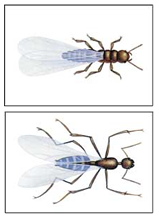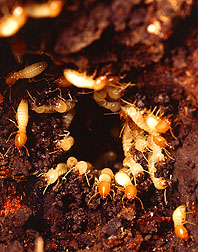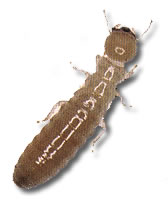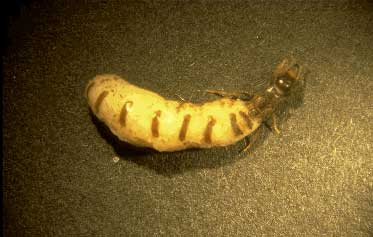A Caste of Hundreds of Thousands
Termites are highly social insects that live in large colonies where populations can reach more than one million. A colony consists of several structurally differentiated forms living together as castes (including reproductives, soldiers, and workers) with different functions in community life.
In the spring, winged reproductives leave the parental nest in swarms to create a new colony. The swarming lasts less than an hour, so it's very likely you'll never even see it. The winged reproductives themselves look quite a bit like flying ants, for which they are often mistaken.
Those "Ants" Might be Termites
| Both ants and termites have two pairs of wings, but ants' wings are different sizes while the termites' wings are all the same size. Also, ants have narrowed waists and elbowed antennae while termites have thick waists and short, straight antennae that resemble strings of beads. Don't be fooled by color or size. Ants can vary in size, and winged termites can be brown or black like ants. |  |
Look for Signs
You're more likely to discover you have a termite problem by discovering the evidence they leave behind rather than the actual termites themselves. If you encounter any of these telltale signs, there's a good chance termites are busy snacking on your home:
- Piles of small, delicate wings shed by reproductives
- Small piles of sawdust
- Mud tubes built by termites for aboveground travel
- Damaged or hollow sounding wood
- Pinholes in drywall or wallpaper
Of course, it's quite possible to have a hidden termite problem even if you never notice any of these signs. The best way to be sure is to contact Spectrum Pest Management to conduct a complete inspection of your home.
Formosan Subterranean Termites
Formosan termites are one of several termite species that threaten homes and other structures in Hawaii and the southern half of the continental United States.
| Originally from mainland China, Formosans have been established in the continental U.S. for only about 50 years. Unfortunately, they are more vigorous and aggressive and successful than native termites. In fact, the Formosan termite has been called the "Super" termite because of its large colonies and its ability to consume vast amounts of wood in a relatively short time. A mature colony of Formosan termites can number in the millions and consume as much as 13 ounces of wood per day. As a result, Formosans can severely damage a structure in as little as three months. Formosan termites are most visible during their annual mating flight. However, they actually cause more damage after the swarm is over. For this reason, it's extremely important to start a control program as soon as you find out that you have Formosan termites on your property. |
 |
Some quick facts about Formosan termites
- Formosan colonies are big. While native subterranean termite colonies might support an average of 300,000 workers, for example, Formosan colonies can average millions of workers - all of them foraging for food (wood).
- A typical colony of Formosan termites could forage an area more than one acre in diameter.
- As Formosans infest a structure, they use soil and wood cemented together with saliva and feces to build hard nests called cartons within walls. Large cartons can actually cause walls to bulge. These nests house thousands of termites as well as hold moisture. Once established, Formosans can live indefinitely without soil contact.
- Formosan termites can also infest and destroy otherwise healthy trees.
- Swarmers are larger than native species, and they swarm in the evening and later in the year (May-June).
- Soldiers comprise about 10% of the colony.
- Formosans will even attack and destroy non-wood materials. They have been known to chew through plaster, plastics, asphalt, and even thin sheets of soft metals like lead and copper.
- Queens can produce 1,000 eggs a day.
Eastern Subterranean Termites
The Eastern Subterranean termite is the most common and most widely distributed termite in North America. It is a problem for home owners from southern Ontario in Canada, south throughout the Eastern United States and as far west as Montana.
This native American pest feeds on such cellulose materials as structural wood, wood fixtures, paper, books, and cotton. Occasionally, it will even attack the roots of shrubs and trees.
A mature colony of Eastern Subterranean termites can range from a low of 20,000 to a high of 5 million workers, with an average of 300,000. The colony's queen will add 5,000 to 10,000 eggs per year to the total.
While Eastern Sub termite colonies are not the largest termite colonies you can find, there will often be more than one of them working in a single building. Signs of Easterns include dirt-colored tubes built to serve as protected paths from the earth to the wood the termites are feeding on, and the translucent wings shed by the kings and queens during swarming. Swarming usually occurs in the spring, but other, smaller swarms can occur throughout the summer and fall.
Some quick facts about Eastern Subs
- An average Eastern Sub termite colony can consume 5 grams of wood per day, the equivalent of 2 1/3 linear feet of a 2'x4' pine board annually.
- Colony growth is slow, and it may take years before swarmers are produced.
- Eastern Sub termites can enter buildings through cracks less than 1/16" wide.
- The termite colony is made up of different types (castes) of termites - each with separate work responsibilities.
- Although Eastern Sub termite colonies are largely located in the ground below the frost line, secondary colonies can exist above ground, and examples of true above ground colonies existing without any ground contact have been seen. However, such above ground colonies have access to moisture and often the source is a roof or plumbing leak.
- Eastern Sub termites will often build mud tubes for travel between their colonies and their food sources.
- The king and queen in a colony can live for 10 to 30 years, while workers live for about two years.
Drywood Termites
Drywood termites live in dry (usually <12% moisture), sound wood and derive their moisture requirements from the wood they consume. Infestations can occur in structural timbers in buildings, pieces of furniture, flooring, doors and doorframes, window trim, wooden picture frames, and other isolated pieces of wood. Their colonies are relatively small, with a few thousand members lacking the true worker caste, and there are often multiple colonies in the same structure.
 |
Drywood termites do not need a connection to soil and there is no soil in their feeding galleries. They do not build mud tunnels; they construct large, irregular galleries that run across and with the wood grain, with a very smooth, clean, and sandpaper-like appearance. The galleries are connected by openings small enough for one termite to pass through. The sure sign of drywood termite feeding is their fecal pellets that are ejected from the galleries via kickout holes, often found right below the damaged wood. These pellets are quite distinctive, and are hard, elongate-oval with rounded ends, and have six concave sides. |
Drywood species
Approximately 400 global species of drywood termite species are known, but only a few species are important in the United States.
Powderpost or "furniture termites" (Cryptotermes spp.) have small fecal pellets and are smaller in size than other drywood termites. Their feeding in furniture or movable wooden objects can reduce wood to a fine powder. They can be found in Florida, southern Louisiana, Texas, Puerto Rico, and Hawaii. The most widespread species is the tropical rough-headed powderpost termite (C. brevis), which is easily distributed by human activity such as transporting infested furniture, and it has been found as far west as Los Angeles and as far north as Ontario, Canada.
The other main group of drywood termites is Incisitermes spp. The most common species in the west is the western drywood termite (I. minor), which is found in southern California, Arizona, Utah, and has become established in Florida. This species infests both dead sections of living trees and wooden articles in homes. The western drywood termite swarming period is midday on warm, sunny days and typically occurs from September-October. However, in Arizona, swarming occurs at night in July.
The southeastern drywood termite (I. snyderi) is found primarily in seven southeastern states, South Carolina, Georgia, Florida, Alabama, Mississippi, Louisiana, and Texas. This species swarms at night, peaking between 8-10 pm, and is attracted to lights. The peak time period for swarming is late May through mid-June.




 Are roaches bugging you?
Are roaches bugging you?